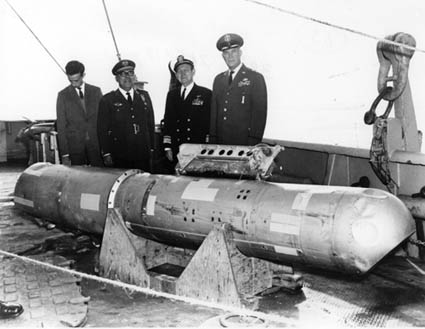For several decades, nuclear-capable nations have transported nuclear weapons around the world. Every now and again there’s an accident.
What Happened:
On January 17,1966 a B-52 bomber was refueling about 31,000 feet over the Mediterranean coast of Spain when it collided with the KC-135 tanker. The tanker ignited and exploded, killing all four of the crew; three of seven of the bomber’s crew died as well when it broke up. The bomber had been carrying four thermonuclear bombs, each with a yield of 1.1 megatons (MT); one drifted safely to the ground beneath its parachute, one was temporarily lost at sea, and the other two experienced a non-nuclear detonation of the high explosives, contaminating about one square miles with plutonium. The weapon that fell into the Mediterranean was located on April 2 at a depth of nearly 3000 feet; it was finally recovered on April 7.
Nuclide(s) and Activity:
Thermonuclear (fusion) weapons produce most of their energy by fusing hydrogen (usually in the form of hydrogen’s heavier nuclides, deuterium and tritium), but that fusion only happens at tremendously high temperatures and pressures – the sort produced during the detonation of a fission bomb. As much as a few tens of kg of plutonium with an activity of several hundred curies were scattered by the high explosive (non-nuclear) detonation and in the form of smoke when some of the pyrophoric plutonium was ignited by the explosives.
Response Efforts:
There were multiple aspects to the response to this incident – recovering the two intact weapons, cleaning up the areas contaminated with plutonium and contaminated smoke, and repairing relations with Spain. Recovering the weapon that came down on land was fairly straight-forward; the one that came down in the sea was much more challenging and involved two dozen Naval ships and smaller craft, four submersibles, a few hundred trained divers, and a smattering of other assets; it also involved using a novel search technique that involved Bayesian statistics, a branch of statistics developed in the 18th and 19th centuries but that was not widely used until the advent of digital computers. And while this did not release any radioactivity into the environment, public concerns on this point and worries about contamination from the other weapons were high enough that the American ambassador to Spain and some Spanish officials went for a public swim in the sea to show the lack of health effects.
Ashore, there was about 1 square mile of land that was contaminated and required decontamination. Soil with contamination levels in excess of about 20 microCuries per square meter were shipped back to the US in metal drums to be buried – this came out to more than 6000 barrels from over 5 acres of land. Another 40+ acres were plowed to a depth of a foot to mix the contaminated soil with cleaner soil beneath.
Nearly 40 years later, in 2004, more contamination was found, and in 2006 some snails and other animals were found to have elevated levels of contamination, with the discovery of another 2000 cubic meters of contaminated soil in the form of two waste burial trenches discovered in 2008.
Health Effects:
It’s hard to determine what the actual health effects were to the 1600+ troops sent to help clean up the plutonium-contaminated soil in Palomares. While there have been some articles written about the plight of these troops (e.g. https://www.nytimes.com/2020/02/11/us/palomares-air-force-nuclear.html and https://www.documentcloud.org/documents/2797013-xxplutonium-2001-USAF-Revised-Dose-Evaluation.html), what’s missing from these articles is the sort of epidemiological data that can be used to evaluate the accounts that are presented.
Here’s the problem – cancer is not a rare disease. About a quarter of Americans will die of cancer, so about 400 of those sent to Palomares to assist with the cleanup would be expected to die cancer and between 600-800 would develop cancer of some sort, even if they were never exposed to radiation. I’ve not been able to find out how many of the troops developed or died of cancer or whether or not the rates of cancer correspond with the amount of radiation exposure – this makes it very difficult to determine which (if any) of these cancers were due to radiation exposure and which would have occurred even had this accident never occurred. Put simply, the information I’ve seen makes it hard to figure out how many of those who developed cancer might have done so as a result of exposure to plutonium while responding to this accident and how many would have developed cancer regardless of their participation in the cleanup.
Other Impacts:
The primary other impacts were the political consequences. In particular, the Spanish government, at that time led by the dictator Fransisco Franco, banned NATO aircraft from overflying Spanish territory when flying to or from Gibraltar, and the US pledged to stop overflying Spanish territory with planes carrying nuclear weapons. Other nations, the Philippines in particular, called for reevaluating such flights as well.
